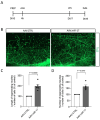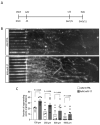AAV-Mediated Expression of miR-17 Enhances Neurite and Axon Regeneration In Vitro
- PMID: 39201743
- PMCID: PMC11355044
- DOI: 10.3390/ijms25169057
AAV-Mediated Expression of miR-17 Enhances Neurite and Axon Regeneration In Vitro
Abstract
Neurodegenerative disorders, including traumatic injuries to the central nervous system (CNS) and neurodegenerative diseases, are characterized by early axonal damage, which does not regenerate in the adult mammalian CNS, leading to permanent neurological deficits. One of the primary causes of the loss of regenerative ability is thought to be a developmental decline in neurons' intrinsic capability for axon growth. Different molecules are involved in the developmental loss of the ability for axon regeneration, including many transcription factors. However, the function of microRNAs (miRNAs), which are also modulators of gene expression, in axon re-growth is still unclear. Among the various miRNAs recently identified with roles in the CNS, miR-17, which is highly expressed during early development, emerges as a promising target to promote axon regeneration. Here, we used adeno-associated viral (AAV) vectors to overexpress miR-17 (AAV.miR-17) in primary cortical neurons and evaluate its effects on neurite and axon regeneration in vitro. Although AAV.miR-17 had no significant effect on neurite outgrowth and arborization, it significantly enhances neurite regeneration after scratch lesion and axon regeneration after axotomy of neurons cultured in microfluidic chambers. Target prediction and functional annotation analyses suggest that miR-17 regulates gene expression associated with autophagy and cell metabolism. Our findings suggest that miR-17 promotes regenerative response and thus could mitigate neurodegenerative effects.
Keywords: axon; damage; miR-17; regeneration.
Conflict of interest statement
The authors declare that they have no conflicts of interest.
Figures






Similar articles
-
AAV-mediated inhibition of ULK1 promotes axonal regeneration in the central nervous system in vitro and in vivo.Cell Death Dis. 2021 Feb 26;12(2):213. doi: 10.1038/s41419-021-03503-3. Cell Death Dis. 2021. PMID: 33637688 Free PMC article.
-
Upregulating Lin28a Promotes Axon Regeneration in Adult Mice with Optic Nerve and Spinal Cord Injury.Mol Ther. 2020 Aug 5;28(8):1902-1917. doi: 10.1016/j.ymthe.2020.04.010. Epub 2020 Apr 15. Mol Ther. 2020. PMID: 32353321 Free PMC article.
-
The assessment of adeno-associated vectors as potential intrinsic treatments for brainstem axon regeneration.J Gene Med. 2012 Jan;14(1):20-34. doi: 10.1002/jgm.1628. J Gene Med. 2012. PMID: 22106053 Free PMC article.
-
Cell death and axon regeneration of Purkinje cells after axotomy: challenges of classical hypotheses of axon regeneration.Brain Res Brain Res Rev. 2005 Sep;49(2):300-16. doi: 10.1016/j.brainresrev.2004.11.007. Epub 2005 Mar 2. Brain Res Brain Res Rev. 2005. PMID: 16111558 Review.
-
Updates and challenges of axon regeneration in the mammalian central nervous system.J Mol Cell Biol. 2020 Oct 1;12(10):798-806. doi: 10.1093/jmcb/mjaa026. J Mol Cell Biol. 2020. PMID: 32470988 Free PMC article. Review.
References
-
- Bouslama-Oueghlani L., Wehrle R., Sotelo C., Dusart I. The Developmental Loss of the Ability of Purkinje Cells to Regenerate Their Axons Occurs in the Absence of Myelin: Na In Vitro Model to Prevent Myelination. J. Neurosci. 2003;23:8318–8329. doi: 10.1523/JNEUROSCI.23-23-08318.2003. - DOI - PMC - PubMed
MeSH terms
Substances
Grants and funding
LinkOut - more resources
Full Text Sources

